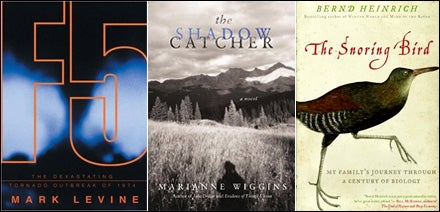WAR TALES, BUDDY NOVELS, long-awaited works by prizewinning authors: It’s a big summer for book lovers. Whether you hump a title into the backcountry or just to the hammock, the crop is worth its weight.
Extreme Mixology
Warm Tecate is no way to end an epic river trip (or anything else). Take it up a notch with a round of orange-basil mojitos, featured in Nicole Aloni’s The Backyard Bartender: 55 Cool Summer Cocktails (, Clarkson Potter).6 basil leaves, sliced
½ oz simple syrup
1 oz fresh lime juice
1 ½ oz light Bacardi rum
juice of ½ orange
soda water
In a cocktail shaker (or Nalgene), muddle the basil leaves, syrup, and lime juice. Add rum and orange juice, pour over ice, stir. Top with soda water and an orange-peel twist.
The heftiest of our lot is (Ecco, $30), by biologist Bernd Heinrich. Gerd Heinrich, Bernd’s father, was one of the last breed of explorer-naturalists, clinging to his love of nature against a dramatic backdrop of poverty, war, and a migration from Poland to America. This engaging memoir is also a fraught exploration of a father-son relationship: Bernd, author of 2001’s Racing the Antelope, would grow up to reject his father’s regimented style—and obsession with ichneumon wasps—but ultimately embrace his biophilic worldview.
If you prefer your literature jacked with adrenaline, try Mark Levine’s (Miramax Books, $26), a nail-biting account of the series of super-strength tornadoes that struck Limestone County, Alabama, on April 3, 1974. Re-creating the human dramas that unfolded that day, şÚÁĎłÔąĎÍř contributing editor Levine masterfully explains the unfathomable: how warm, moist air from the Gulf of Mexico met up with an upper-level disturbance from Alaska to create storms expected once every 500 years.
In a clever hybrid of novel, mystery, and biography, Marianne Wiggins (Evidence of Things Unseen) explores the life of 20th-century photographer Edward S. Curtis, famous for his portraits of Native Americans, in (Simon & Schuster, $25). Wiggins interweaves Curtis’s story with that of her present-day narrator, a Curtis expert named Marianne Wiggins, who admits to being a little in love with her subject. Yet his images, she notes, were staged. “Not once in your life,” she says, “did you ever photograph an Indian when he or she was laughing, eating, embracing … as if to say, This is who we were, and we were happy.”
In (Viking, $24), his first novel in 26 years, short-story impresario Ron Carlson turns his spare prose loose on three loners brought together by a construction job on a remote ranch in Idaho. All broken in different ways, the men seek meaning in the landscape as they work on a project that symbolizes everything wrong with the West today—building a motorcycle ramp at the edge of a canyon so the rancher can televise a Knievel-like stunt and get rich. “In his business in Los Angeles,” Carlson writes of one worker, “he’d avoided such work . . . a lot of money meeting in some bad, temporary place.”
Centered in the wild dunes of midcentury Cape Cod, Annie Dillard’s new novel, (HarperCollins, $25), follows the marriage of Toby and Lou Maytree. Bohemians at heart, he writes epic poems to understand the nature of love, and she just loves. When Toby runs off with an even more bohemian dune-dweller, both Maytrees must redefine their projects. Dillard, who established her nature cred in 1974’s Pilgrim at Tinker Creek, here employs a breathier, lighter touch. Lou, she writes, “longed for the life she already possessed, a life large as clouds.”
Family dynamics also lie at the heart of Michael Ondaatje’s much-anticipated (Knopf, $25). Set in the Gold Rush country of Northern California and in southern France, the novel follows the Mendez family as a single act of violence cleaves it in half. As always, Ondaatje, who won a Booker Prize for The English Patient, matches his raw, indomitable landscapes with language that alternates between forceful and poetic. “There is the hidden presence of others in us, even those we have known briefly,” he writes. “We contain them for the rest of our lives, at every border that we cross.”
OUT IN THE COLD
Roughly halfway into his 2002–04 paddling/skiing/kite-skiing/bicycling/sailing journey around the Arctic Circle, South African adventurer Mike Horn, 40, had already survived temperatures of minus 75 degrees Fahrenheit and lost his tent in a butane-stove fire. The rest of his solo 27-month trip, chronicled in (St. Martin’s, $28), proved equally grueling. Next on his calendar: a human-powered circumnavigation of the world, set to launch in March 2008. A quick look at the stats from his Arctic odyssey makes it clear Horn is up to the challenge.
—DIANNA DELLING


